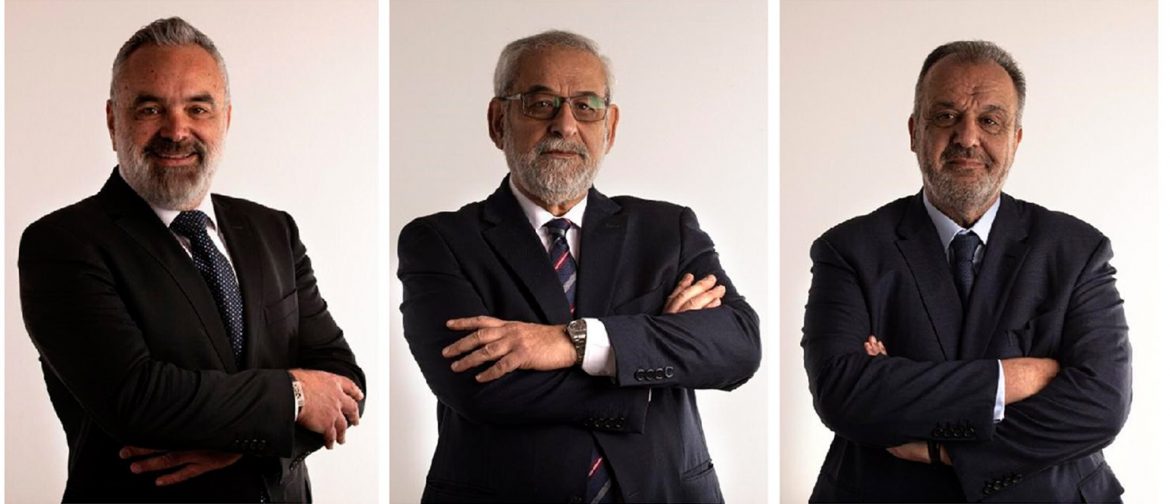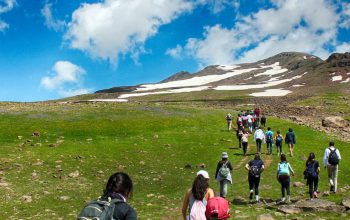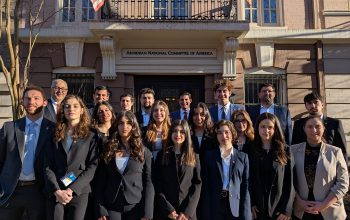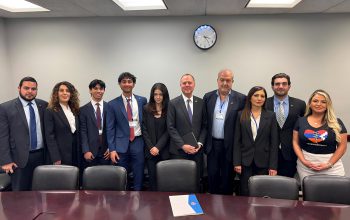By Yeghia Tashjian – Armenian Weekly
The Crisis and the Road Toward Elections
Lebanon has been suffering from a severe financial crisis since October 2019. The crisis was further exacerbated by both the COVID-19 pandemic and the deadly explosion at the Beirut port on August 4, 2020. The roots of the crisis run deep. The country experienced liquidity shortages in the years prior to 2019, but the fragility of the economy was buried by the financial engineering of the Central Bank and the political leadership, which sank the country into systematic corruption and ultimately institutional collapse.
Following the collapse of the banking system (one of the main pillars of the Lebanese economy), the country has been in the throes of hyperinflation. The Lebanese pound has lost 95 percent of its value and continues to decline. The country is also facing record-high unemployment, poverty, an increasing crime rate as well as severe shortages in water, food (mainly bread), gasoline, medicine and electricity. According to ESCWA, around 82 percent of people in Lebanon live in multidimensional poverty, compared to 42 percent in 2019. The economic crisis is considered to be among the three worst in the world since the mid-1800s.
To top it off, Beirut was the site of the third-largest non-nuclear explosion in history, which killed 217 people and injured more than 700 others. The destruction displaced some 300,000 people and caused billions of dollars in damage across the capital. Due to a lack of state funding, people had to renovate their homes and businesses at their own expense.
According to a World Bank report dated January 2022, “the scale and scope of Lebanon’s deliberate depression are leading to the disintegration of key pillars of Lebanon’s post-civil war political economy. This is being manifested by a collapse of the most basic public services; persistent and debilitating internal political discord; and mass brain drain.” The report concluded that Lebanon’s deliberate depression is orchestrated by the country’s ruling elite that has long captured the state and absorbed its profits.
To save the country from total institutional collapse, the government, under international pressure, pledged to hold the parliamentary elections on May 15, 2022. Election day saw severe competition between Hezbollah, the Lebanese Forces (LF) and the Free Patriotic Movement. As one of the largest seven communities in the country, Armenians participated in the elections as well. The Armenian Revolutionary Federation (ARF) had four candidates. The Social Democratic Hunchakian Party (SDHP) had one candidate, and the Armenian Democratic Liberal/Ramgavar Party supported the candidates backed by the ARF and the SDHP. A total of six Armenian seats are allocated to the community (five Armenian Apostolic/Orthodox and one Catholic, divided among electoral districts where Armenians are mainly concentrated—one seat in Zahle, one in Northern Metn and four in Beirut I). However, in addition to the Armenian candidates backed by the traditional political parties, there were dozens of Armenian independent candidates backed by non-Armenian political organizations and civil society opposition groups. There was fierce competition mainly in Northern Metn and Beirut I electoral districts.
By May 16, the vote counts were clear; no side won a complete majority. Unlike the 2018 parliamentary elections, Hezbollah and its allies lost their complete parliamentary majority, but they still control more than 50 percent of the Parliament. The Lebanese Forces Party and its allies barely formed the largest parliamentary block, making way for new young and civil-society-backed independent faces in the legislature. On the Armenian community level, the ARF preserved its three seats (lost one seat in Beirut I and gained a seat in Zahle). The MPs are ARF Central Committee representative Hagop Pakradounian (Northern Metn), Hagop Terzian (Beirut I) and George Bouchikian (Zahle). Jihad Pakradouni (backed by the Lebanese Forces Party) gained a seat in Beirut I. Civil society-backed Paula Yacoubian and independent Jean Talouzian preserved their seats in Beirut I.
I will highlight and analyze the outcome of the general elections and its impact on the Armenian community, which is also facing financial challenges. Armenians in Lebanon are the only community with shrinking demographics as many families emigrate and the death rate surpasses the birth rate. I will also critically assess the decrease in the number of votes gained by Armenian political parties compared to the slight increase in the number of Armenian votes gained by independent Armenian or non-Armenian candidates between the 2018 and 2022 parliamentary elections. I will conclude with a few recommendations for new strategies and the need to adopt a vision for the future of the community.
Election Results and the Prolongation of the Crisis
-Unlike in 2018, Hezbollah no longer enjoys a full majority in the Parliament. It lost Christian allies, but it also gained some Sunni allies. Interestingly, the Syrian government also lost some allies. The Syrian Social Nationalist Party, one of the largest secular pro-Syria political parties, lost all of its seats due to internal divisions. There was also exaggeration in the Western mainstream media that the “anti-Hezbollah camp and the opposition were victorious.” This power shift (Hezbollah not enjoying a complete majority) does not necessarily mean that the pro-American/Saudi camp now has a majority in the Parliament. The Lebanese Forces and the Phalanges alongside other Western-oriented independent MPs cannot form a majority. In order to gain a majority in the Parliament, both sides have to try to attract and win over the independent and civil society-backed MPs and cooperate with their rivals. It is worth mentioning that many of these new independent MPs are very flexible and not able to form a unified opposition parliamentary bloc since they are diverse. Some of them are leftists, others liberals and some have political affiliation with other local or regional players. Hence, not all civil society-backed opposition MPs are “pro-Western” as the Western media have portrayed.
-With a 49 percent voter turnout, the Lebanese Forces party has the largest number of MPs—19. Its Christian rival—the Free Patriotic Movement (FPM), which had the largest parliamentary bloc—brought 17 seats and gained much fewer votes. However, combined with the ARF, the FPM will again preserve its largest parliamentary share. Hence, both the FPM and the LF will try to attract some independent MPs to increase their parliamentary share.
-The Saudi embassy has been cautious not to publicly support any side though there are rumors that Saudi Arabia has financed anti-Hezbollah groups learned from its past mistakes never to put all its eggs in one basket. The embassy will support groups like LF, Phalanges and independent Sunni blocks to contain the Iranian influence in Lebanon. Also, former PM Saad Hariri’s Future Movement brought eight MPs despite not formally running under the Future Movement banner. This could pave the way in the future to bring Hariri back to politics.
-Turkey also gained some loyal MPs. Turkey had been active in Lebanon with its soft power politics. After the elections, many Sunni MPs and politicians rushed to the Turkish embassy to get “blessing and political support” from the ambassador. Two candidates, one in Tripoli and the other in Beirut II electoral districts with close ties with Ankara, entered the Parliament.
-It is unclear how the next cabinet will be formed, if the LF will join and how it will engage with Hezbollah. Many analysts share their concern that this era will witness a lot of security concerns, similar to the Tayouneh incidents where supporters and partisans of LF clashed with Amal and Hezbollah armed partisans. Diplomatic sources also expressed some concerns to me about potential clashes in the future between Hezbollah and the Arab Sunni tribes in Khaldeh. Such events may continue until the Presidential elections (October 2022). There are concerns that the Sunni-Shia conflict may be replaced by a Christian-Shia conflict and this will be disastrous for the Christians but will also threaten Hezbollah’s “Christian legitimacy.”
– Historically, whenever the balance of power shifts in Lebanon, the country ends up in a conflict/crisis. This was the case in 1958, 1975 and 2008. If some members of the civil society ally with the LF and other anti-Hezbollah forces and try to challenge the current system and Hezbollah, then Hezbollah may react. Some analysts argue that regional actors may push some politicians toward such a scenario to provoke the system and facilitate its collapse and arrange a new political and economic system in Lebanon.
– If the MPs fail to select a PM to form a new cabinet, the current (resigned) government will take care of the country until the Presidential elections in October (if a President is elected). I fear that Lebanon may end up in an institutional crisis. If the Presidential office is vacant, constitutionally, the Parliament cannot consult to select a Prime Minister. Hence, the executive branch would be completely paralyzed. Thus, the 2008 scenario will be repeated and street clashes may occur between Shias and Christians. This may require regional and Western intervention, and foreign powers may impose an agreement or a new system on Lebanon similar to the Taif agreement in 1989 or the Doha agreement in 2008.
-The major parliamentary blocs will consult the President, and a government will be formed. With the end of President Michel Aoun’s term, the new government will take the executive role as the Presidential powers will go to the cabinet. Some may fear that the President would transfer his power to the army chief and not the Prime Minister’s office. This may invite constitutional problems and drive the country to institutional collapse which may force the emergence of a new political system. The economic situation will also worsen. A major European diplomatic source confirmed to me that Europe is not ready to help Lebanon if the government doesn’t adopt structural reforms, and some European leaders are seriously thinking of letting the country collapse so that politicians “beg for mercy” and agree on reforms. This will be very painful for the poor and middle-class as Lebanon is witnessing a brain drain.
Challenges in the Armenian Community
According to Joanne Randa Nucho, Armenian political parties have been involved in larger inter-confessional alliances and factions within the Lebanese political world for decades. Lebanese Armenians are now more visible and vocal players in Lebanese politics; their objective has been the safety and security of Armenians. It is worth mentioning that after the end of the Civil War in Lebanon (1975-1990) and the emigration of thousands of Armenians, their political influence has been limited compared to the 1960s and early 1970s. That’s when the number of Armenians exceeded 200,000 in Lebanon, and they were represented with strong, active leaders. Media attention was given in the last few elections to the Armenian “swing vote” as the one sect that could determine which political faction would become dominant. However, since 1992, the percentage of Armenian voters has been around 24 percent of registered voters. Many Armenians had emigrated and upon their deaths, their names have not been omitted from the registered voters lists. The Armenian community is the only community in Lebanon where its number is shrinking; this is mainly because of emigration, and the new generation abroad is not being encouraged to apply for Lebanese citizenship.
Despite that, the community and its institutions are still active in safeguarding the political rights of the Armenians on one hand and addressing the minimum social, educational and economic needs of the community. In December 2020, in collaboration with the German Konrad Adenauer Stiftung, I published a paper titled “Communitarianism and Crisis Response: The Model of Lebanese-Armenians” where I highlighted and analyzed the role of Armenian political, social and religious institutions in shaping the life of the community. These institutions led by the churches or parties were influential in fundraising and addressing the needs of the Lebanese-Armenians in times of crisis. For example, the ARF-led Parliamentary bloc had already implemented several social and educational projects for Armenians, such as granting scholarships for Armenian university students, covering marriage expenses in church and giving financial aid to families with more than three children. The party also initiated the COVID Crisis Committee which raised money for Armenian families in need and provided them with ration packs, medical assistance and free hospitalization for all those who were affected by the pandemic. During the Beirut blast, hundreds of youth and volunteers from the ARF, SDHP and AGBU were on the streets in eastern Beirut and Bourj Hammoud to help injured families, shelter them and renovate their houses.
Nevertheless, despite this, the voting share of the Armenian political parties has slightly improved. In 2018, Armenian political parties brought 12,924 preferable votes out of the 24,707 total Armenian voters. In 2022, Armenian political party candidates brought 13,567 preferable votes out of the total votes. In an interview with the policy and research specialist at Information International Mohammad Chamseddine, the researcher highlighted that the number of Armenian voters in 2022 was around 21,000. It’s worth mentioning that not all of the remaining Armenian votes went toward independent Armenian candidates; non-Armenian candidates took a share as well. This trend was new for the Armenians. On the other hand, for the sake of comparison, by counting the sectarian preferable votes for the three ARF elected MPs and the candidates, we see that 70 to 90 percent of their voters were Armenians. Armenian MPs and candidates who were supported by non-Armenian political parties or civil society opposition groups gathered less than 10 to 20 percent of Armenian votes and were elected mainly by non-Armenian voters. In this context, it is important to mention that non-Armenian candidates have also attracted a large number of Armenian voters. This trend has been increasing over time, either due to vote buying or political affiliations.
To address the above-mentioned gap, questions should be raised to improve the situation and adopt programs to attract the youth and engage them in community work and political activism.
Future Questions and Recommendations
This analysis has shown that the strength of mobilizing the votes of Armenian voters in favor of Armenian traditional political parties is decreasing. While votes have increased compared to 2018, the share of Armenian votes for non-partisan or non-Armenian candidates has also increased. Even though the parties and their sister organizations are doing enormous humanitarian work (COVID-19 crisis response, renovating properties damaged due to the Beirut Port explosion, providing monthly stipends and food to needy families), there is still a gap between the leadership and the young generation. The traditional political parties must try to narrow this gap by incorporating the youth in the junior-level decision-making process so that they feel their voices and demands are not suppressed nor isolated but heard and appreciated. Our institutions will prosper as these young people will bring their creative and progressive initiatives and merge with the institutionalized ideas of the traditional institutions. This may be a challenging task as traditional institutions historically always clash with reform and modernization. However, reforms can be the best cure to avoid a future vacuum or institutional crisis and facilitate power transition.
Generally, though not necessarily always the case, the young generation has always been rebellious and the first to jump on waves of change. Unlike the old generation, the young generation has not witnessed the horrors of the Lebanese Civil War and has not seen the sacrifices of the youth of Armenian political parties while defending Armenian neighborhoods and properties (churches, schools, shops and residences). Therefore, mentioning the sacrifices of the older generation during electoral rallies or campaigns for political gains is not useful as these memories have lost the sense of mobilization among the youth. This is a common issue where our political parties fall into the trap of history. Elections are not about the past but about the future. The attendees of the rallies are neither historians nor are interested in history lessons; they are citizens concerned about their future.
With the wave of globalization, there is a renewed attack against everything associated with institutions and traditionalism. For this reason, political parties, religious institutions and often any bureaucratic association have been a target of such criticism. How to avoid such criticism? Armenian political parties in Lebanon and generally in the Middle East, after the experiences in Iraq, Syria and other countries (wave of terrorism, authoritarianism), have developed a certain immunity against modernization, became conservative and avoided taking extreme political positions by not addressing public demands. Instead, they secluded themselves in communitarianism and community activism. This trend has not been welcomed by the general youth class whose demands have gone beyond communitarianism. Now that the youth have individual demands, which are a reflection of basic rights of a citizen, such as public health care, having full access to clean water, electricity, environmental rights, employment and security, political parties must balance between community activism and public demands. For this reason, balancing between communitarianism and public life is essential and being transparent about public life is important to inform the citizens of the public activities of the representative parties and their MPs or ministers.
Political and electoral rallies and campaigns should not be a form of a public crusade against the rival; that is, not what he/she is or hasn’t done, but what I/me/us have done and can/will do. Interestingly, in the past two parliamentary elections, the Armenian political parties (mainly the ARF) have always called for pan-partisan unity and called those who would not like to vote for the ARF then at least to vote for other Armenian political parties since only Armenian political parties can represent the interests of the community, as individual candidates supported by non-Armenian political parties lack communal legitimacy. Hence, electoral competition within the Armenian community is no more between different traditional political parties but between the parties and individuals, whether independent or supported by non-Armenian political parties, that had never been associated with community life. Ironically, during the electoral campaigns, rarely partisan candidates touched on the enormous humanitarian, educational and social work that the political parties have done and are still doing to address the needs of the people in Armenian neighborhoods. Meanwhile, the number of independent Armenian candidates is growing, and their voting share from the community is still minimal, but a slight increase has been recorded in the last four years. Moreover, non-Armenian candidates in Beirut I and Northern Metn also have gained votes from Armenians. Of course, vote buying has played its role, but many have voted with free will. The concern of these Armenians must be addressed. Is this because many young Armenians need to see a change outside the traditional community institutions? Is this because they are tired of the same faces representing the community? Is this because the partisan electoral slogans no more attract and mobilize them? These are questions that need to be addressed, studied and analyzed.
Finally, Lebanon in 2022 is not the same as it was in 2018. The community, like other communities, is suffering from a severe brain drain. Many young professionals are leaving and the ones living in Lebanon are suffering from unemployment, searching for jobs or simply suffering from the financial crisis. The crisis has hit the poor and the middle class. It is no longer just about a financial issue, but it’s also a matter of physical and psychological pressure. New active young faces are needed in the community to keep the Lebanese-Armenian society strong. To attract the youth, especially those who are detached from community life, cultural, sports programs or summer camps can be organized to bring the youth together and discuss and debate ways to reform and strengthen community institutions, assess the current socio-economic situation and incorporate “new blood” in community work. The current MPs can also learn from the experiences of professionals and draft laws and regulations that address the public needs. A certain mechanism can also be adopted to push fresh graduates as interns and work with the MPs to learn how to frame laws and regulations and engage in political and economic consultation.
Yeghia Tashjian is a regional analyst and researcher. He has graduated from the American University of Beirut in Public Policy and International Affairs. He pursued his BA at Haigazian University in political science in 2013. In 2010, he founded the New Eastern Politics forum/blog. He was a research assistant at the Armenian Diaspora Research Center at Haigazian University. Currently, he is the regional officer of Women in War, a gender-based think tank. He has participated in international conferences in Frankfurt, Vienna, Uppsala, New Delhi and Yerevan. He has presented various topics from minority rights to regional security issues. His thesis topic was on China’s geopolitical and energy security interests in Iran and the Persian Gulf. He is a contributor to various local and regional newspapers and a presenter of the “Turkey Today” program for Radio Voice of Van. Recently he has been appointed as associate fellow at the Issam Fares Institute for Public Policy and International Affairs at the American University of Beirut and Middle East-South Caucasus expert in the European Geopolitical Forum.




